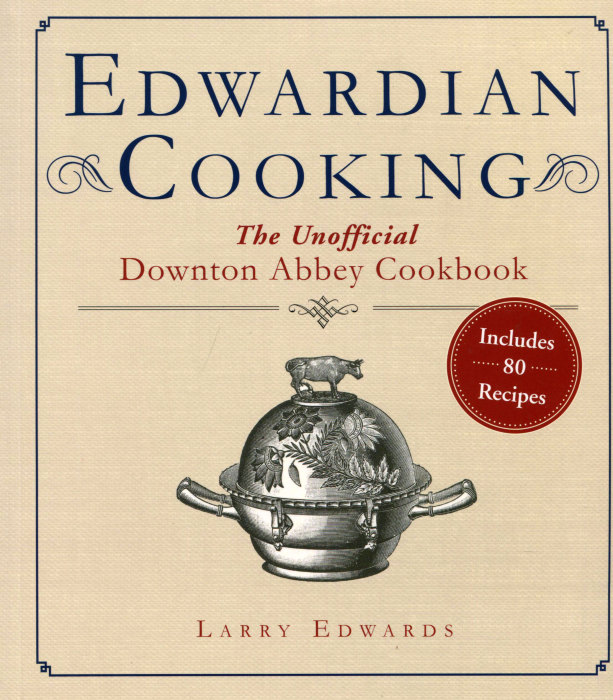Edwardian Cooking by Larry Edwards is not a family cookbook. It is an historical cookbook about the food of the upper classes in Edwardian England, that is England after Victoria and extending through World War 1.
The book is subtitled The Unofficial Downton Abbey Cookbook.
I did not start out as a fan of Downton. I am not a soap opera person. By heritage I am peasant Irish. I maintained I would not find the English upper class entertaining.
“You should watch,” Suzen began during Season 1.
“You need to watch,” was the mantra during Season 2.
“Sit down and watch,” was the command for Season 3.
And I like it. There is just enough killing off of the upper class, by violent means at times, to make me happy. And last year, not to give away too much, the butler did it. Yes, the butler really did kill someone and it was good vigilante justice and everyone just let it slide. Bad guy meets deserved grisly end.
Definitely a show with a deep Irish slant.
And food. Lots of food.
There are eighty recipes in Edwardian Cooking, all authentic although modified at times for the modern kitchen. We don’t have treacle readily on hand, but molasses is there on the store shelves. We don’t have Devonshire cream, but there are recipes aplenty of how to use mascarpone or sour cream plus heavy cream and sugar to create “faux” Devonshire.
What a shame that afternoon tea has disappeared. The best thing we have now is clusters of people at Starbucks getting a late afternoon caffeine hit and tweeting, not talking, as they sip. But, but, Starbucks has announced they will be serving wine and doing deliveries, so even this afternoon gathering is threatened. A shame repeated.
The book begins with a chapter devoted to that afternoon tea and the classic, delicate High Tea Finger Cookies, plus richer Brown Sugar Honey balls. The recipes intrigue here because they have been extensively researched so that the original ingredients, often slim in number, are presented with simple, almost stark instructions for preparation. Yes, the Downton Abbeys of England had big kitchens and big staffs, but they did turn out complex French-style dishes [until the 1920’s]. No, at this point of time, the dishes were English, fundamental and perfected after centuries of evolution.
Besides sweets, tea could involve savory items, some very unusual. There is the Iced Camembert where Camembert, wine, heavy cream, bread crumbs, Parmesan, and paprika are combined, chilled, then softened and ready for use on glorious English crumpets or popovers. Or Cucumber and Cheddar Tea Sandwiches with Horseradish Cream.
For dinner, Edwardian tables were typified by the series of courses that engendered a long evening of dining. England produces cheese and cheese soups are here in full force: Royal Cheddar Cheese Soup and Stilton Chowder. It turns out potatoes were eaten both the peasant Irish and the upper class, so you find Potato and Pea Soup and Majestic Potato Cream made with mashed potatoes.
Side dishes in Edwardian Cooking are ones you want to try for yourself. How about:
- Baked Eggs and Mushrooms in Cheddar Cream
- Asparagus in Cider Sauce
- Baked Cream Turnips
- Shredded Spiced Brussels Sprouts
The headnotes for these recipes are exceptionally well written. You get the how and why for each recipe, when they could be served during the year, and how the recipe might be altered during seasons. That Asparagus in Cider Sauce, for example, was intended to have contrasting sharp flavor to balance seafood dishes.
The chapter on entrees is equally eye opening. Roast beef served five different ways? No, actually, beef was not the protein staple. It was pork and lamb. The Leg of Lamb recipe here is deeper and richer than what you might expect: garlic and thyme and marjoram, of course, but also vinegar, honey, cinnamon, cloves, ginger and apples.
Again, you might think of meat loaf as a peasant dish. But there are meat loaves here for the upper class, but now rich with the addition of veal or apples. These are recipes for you enjoy now and, no, you don’t need a large kitchen staffing working 12 hours a day in the basement. You can eat without guilt or great expense, but surely with great pleasure.
Edwardian Cooking closes with, what else, desserts, some grand ideas that have escaped common usage and some wonderful, timeless recipes that we still all enjoy. The Devonshire Strawberry Shortcake is said to be the “original” dessert, the one that we should all try. That’s why I mentioned above that, while it may be hard to buy Devonshire cream, you can easily make your own faux, but still acceptable version.
There are pound cakes, including a sour cream version, to be used year round as the accompanying fruit shifts with the seasons or you resort to Devonshire cream in the dead of winter. There’s a honey cake that smiles at you from the pages and something called Apple Noodle Pudding that seems a perfect fit for a winter evening feast.
You will find many ways to enjoy Edwardian Cooking. It offers history aplenty giving you a rather different perspective on Edwardian life. There are “lost” ideas here, like the Apple Noodle Pudding, that deserve renewed attention. And there is proof that Leg of Lamb is forever classic, particularly when you add cinnamon sticks.
The next season of Downton begins very soon. Time for grand, multi-course Sunday feasts, served late as you watch to see who dies next. Or is shoved under a bus because they deserve it. Why not make the meal delicious and authentic.
Just pass around the tissues and the Devonshire cream.

